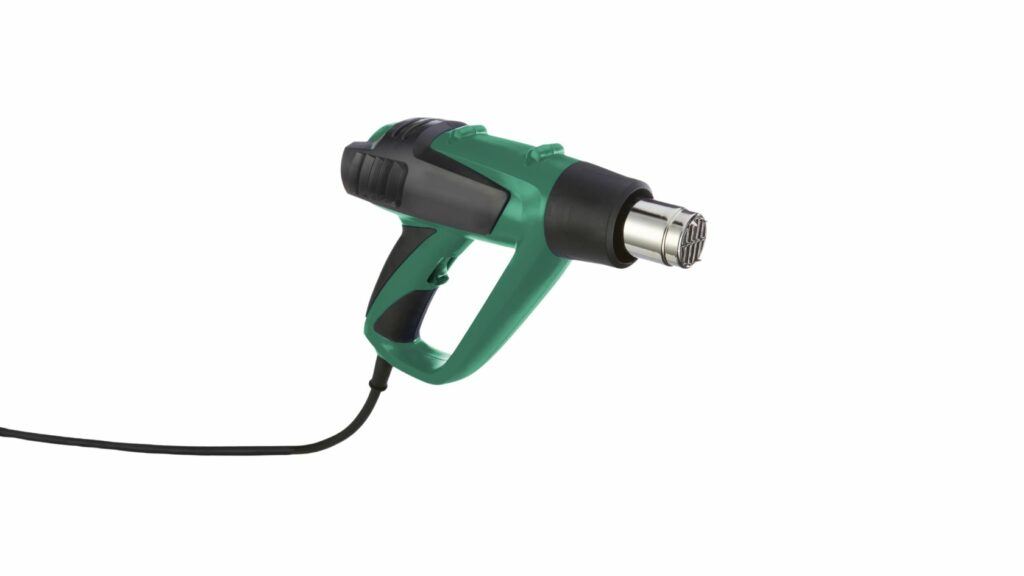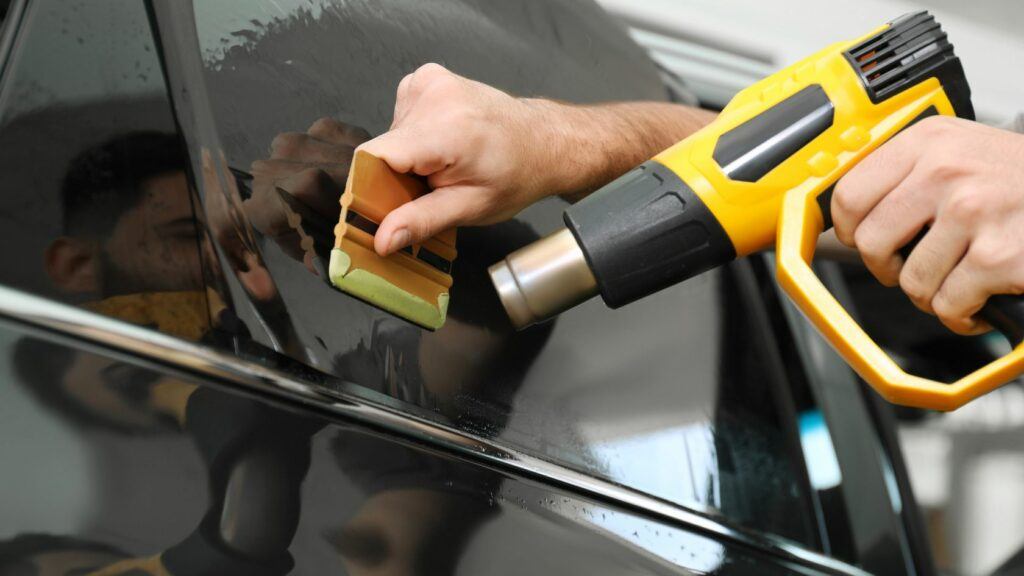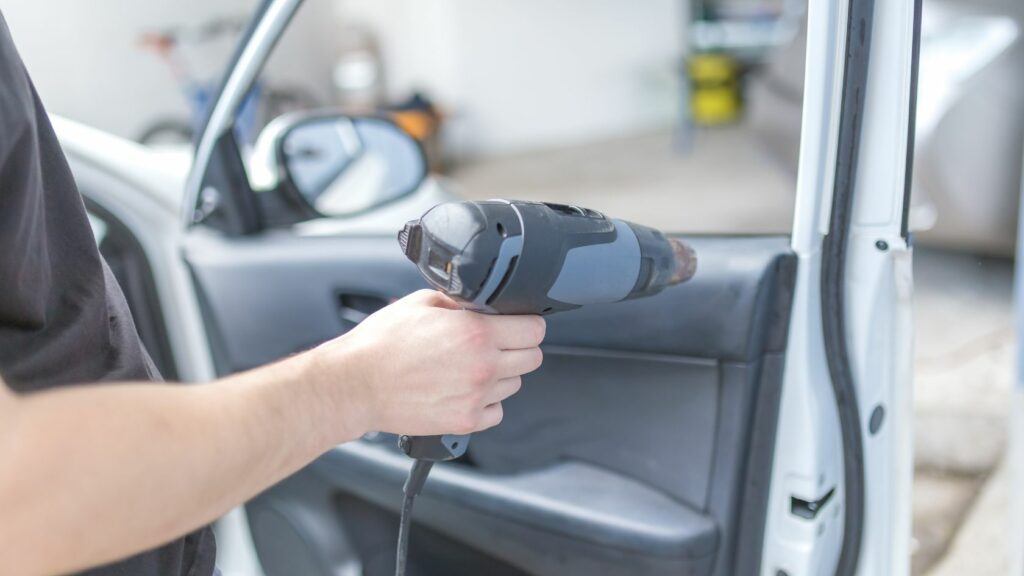
Automotive maintenance, repair, and customization become much easier if you have the right tools at your disposal. The heat gun is one such versatile tool that often flies under the radar but deserves more attention.
Heat guns offer various benefits while detailing different car and motorcycle parts.
In this blog post, we’ll explore how a heat gun can be a game-changer for automotive enthusiasts, delving into its automotive applications, benefits, and usage.
You will also find comprehensive details on buying factors for choosing a heat gun and the 3 best heat guns to make your selection easier.
What is a Heat Gun?
A heat gun is a handheld device that releases a stream of hot air when activated. It typically features adjustable temperature settings and a nozzle that directs the hot air where needed.
What is a Heat Gun Used For in Automotive?
One of the most common uses of a heat gun in automotive work is paint removal. A heat gun can efficiently soften and strip away layers of old paint while restoring or customizing your vehicle’s appearance.
The process with a heat gun is quicker and less abrasive than using chemical paint strippers, reducing the risk of damaging the underlying surface.

A heat gun is also indispensable for achieving a smooth and wrinkle-free finish while vinyl wrapping cars or motorcycles.
Using a heat gun, the vinyl can be made more pliable, which helps in stretching and conforming it to complex contours. This ensures a professional-looking result.
Many automotive components, such as bumpers and interior trim pieces, are made of plastic. When these parts crack or break, a heat gun can be used for plastic welding and repair.
By melting the plastic together, you can restore the integrity of the component, saving you money on replacement parts.
Heat guns are also effective for removing rust from metal surfaces. Heating the rusted area makes it easier to scrape or brush away. Additionally, if you have stubborn adhesive residue from stickers, decals, or trim, a heat gun can soften the adhesive, making it simpler to remove.
Lastly, electrical work! Heat guns are invaluable for heat-shrink tubing applications. They evenly and precisely shrink the tubing around wires and connectors, providing electrical insulation and protection. This is crucial for custom wiring jobs or repairs.
Benefits of Using Heat Gun for Automotive Works
Precision and Control – Heat guns provide precise temperature control, allowing you to tailor the heat output to the specific requirements of your automotive task. This precision is especially crucial when working on delicate components or when avoiding damage to adjacent areas.
For example, vinyl wrapping! Using a heat gun, you can heat the vinyl at just the right temperature to make it pliable without risking overheating and damaging the material. This level of control ensures a smooth and bubble-free application.
In contrast, using a torch or an open flame lacks the precision of a heat gun and can easily scorch or ignite materials, making it unsuitable for many automotive applications.
Time Efficiency – Miscellaneous mechanical methods such as scraping or using of chemical solvents on automotive tasks can be time-consuming. Moreover, it may also not yield neat and efficient results.
Heat guns, on the other hand, can significantly reduce the time required to perform different automotive works. The controlled heat applied by a heat gun speeds up any process related to paint removal, softening adhesive, or molding plastic components.
Without a heat gun, these processes can be tedious and lengthy.
Versatility – Heat guns are versatile tools that can handle a wide range of automotive tasks. With a heat gun in hand, you can perform paint stripping, plastic repairs, electrical work, and many more.

In comparison, other tools may be specialized for specific tasks which means investing in a variety of equipments for a single task. A heat gun is a go-to tool for various projects eliminating the need for multiple tools.
Safety and Environmentally Friendly – When removing old paint using chemical strippers, you expose yourself to potentially hazardous chemicals and generate toxic fumes. In contrast, a heat gun eliminates these risks while effectively softening the paint for removal.
Heat guns are generally safer and more environmentally friendly than alternative methods. They don’t emit harmful fumes or require the use of chemicals, making them a cleaner option.
3 Best Heat Guns for Automotive Work
Here is the list of 3 best heat guns for your automotive work that will save you time on researching and reduce confusion:
As an Amazon Associate, we may earn a small commission if you purchase any product by clicking the links without any additional cost to you.
If you’re in search of a heat gun that can handle a diverse range of applications with ease, the SeekOne 1800 Watt Heat Gun deserves your attention.
The SeekOne heat gun packs a hefty 1800 watts of power under its hood. It’s equipped with a straightforward two-position switch, allowing users to toggle between low and high settings. This versatility ensures that you have the right amount of power for various tasks.
The variable temperature control option is accessible via a wheel on the back of the heat gun. This feature provides precise control over the heat output, making it suitable for an extensive array of applications.
This heat gun can reach temperatures exceeding 400 degrees quite effectively for various heating tasks without compromising reliability and accurate temperature control.
SeekOne has included several attachment accessories to maximize the heat gun’s versatility. These attachments include concentrators designed to focus heat on smaller areas, a scraper-style attachment for wider heating bands, and a deflector plate.
The deflector plate can be customized to create specific heat distribution patterns, making it ideal for precision work.
There is a built-in kickstand that allows the heat gun to stand upright on a flat surface, freeing up your hands for more precise tasks. This feature is especially handy when working with wires or performing heat shrink applications.
In terms of safety, users get an on/off switch on the back of the gun. The variable temperature control wheel also contributes to precise heat adjustments. These safety features ensure that users have control over the tool’s operation, enhancing both safety and precision.
Pros
- High-wattage powerhouse with 1800 watts
- Included attachments enhance versatility
- Built-in kickstand allows for hands-free operation
- The deflector plate can be customized for specific heat distribution patterns
Cons
- No Cordless option limits its portability
- Higher wattage may require caution to avoid overheating or damage to materials
Wagner Spraytech Furno 500 Heat Gun
The Wagner Spraytech Furno 500 heat gun comes with a temperature range that can be adjusted depending on your needs. It can stretch from a toasty 150 degrees Fahrenheit to a scorching 1200 degrees Fahrenheit making it feasible for a wide range of tasks including automotive.
In terms of variety, this heat gun gives you close to a dozen different temperature settings. That’s like having a heat dial with a dozen options, ensuring you get just the right amount of heat for your job.
You can see the set parameters on its LED screen and make the changes accordingly with a push button.
Talking about the output, the Furno 500 brings two fan speeds to let you control how fast that scorching air hits your project, providing precision in your heat application. However, some more fans could have taken the output to the next level.
The Furno 500 also boasts a robust cooling system that ensures this heat-spewing beast keeps running smoothly. This means it can last long without compromising safety.
When it comes to handling, this heat gun’s ergonomic design ensures you can handle it comfortably for extended periods without feeling like your arm is about to give up. It won’t weigh you down as it weighs just over a pound.
You get two nozzles in the package. A glass protector nozzle can be used to work safely on glass surfaces and a flare nozzle to spread the heat across long and narrow areas.
The design of Furno 500 is another advantage. It has sidebars to keep the nozzles at a fair distance to prevent unwanted damage. It also has a hanging loop so that you can save space as much as you can.
In a nutshell, this 1500W wonderful heat gun from Wagner is your go-to product for various heating needs. It emits both low and high heat, and its 12 temperature settings are versatile enough for precision heating for a multitude of tasks.
Pros
- Ergonomic design supports hands-free operation
- Very easy to handle and operate
- Comes in a variety of temperature settings
- Versatile to use on different surfaces and perform multiple tasks
Cons
- Comparatively expensive
- Comes with only two fans results in low output
If you’re looking for a versatile and reliable heat gun, the DeWalt DCE 530B should undoubtedly be on your radar.
The standout feature of this heat gun is its exceptional temperature range. Whether you need to remove paints, labels, shrink heat shrink tubing, or even bend plastics, this heat gun can go from 150 degrees to 1200 degrees Fahrenheit
The DCE 530B offers two fan speeds, allowing you to control the rate at which hot air is directed. This feature is incredibly handy as it enables you to adapt the tool’s performance to different applications.
From a usage perspective, DeWalt’s well-sized grip ensures that you can comfortably hold and operate the heat gun for extended periods without discomfort or fatigue. Weighing a little over a pound, this heat gun is remarkably lightweight.
Its portability makes it an ideal choice for those who need to use it on the go or in tight spaces. You won’t be weighed down by heavy equipment, yet you’ll still have the power you need at your fingertips.
In terms of accessories, one of the included attachments is designed to help you evenly heat cables for heat shrinking. It’s a thoughtful addition that ensures even and efficient heat distribution along the entire cable, eliminating the need to constantly rotate it.
DeWalt has also incorporated safety features to prevent accidental activation. It comes with a lock button that ensures the tool won’t turn on unintentionally, a valuable feature when storing it in a toolbox or carrying it on the go. Additionally, the safety button on the trigger adds an extra layer of security.
Pros
- Offer versatile temperature range for a wide range of tasks
- Comes with a practical attachment for precise heating
- Lock button and safety trigger enhance security
- Ergonomic design provides a comfortable grip for extended use
Cons
- Battery power limitation may not be suitable for all-day tasks that require continuous power
- Lacks efficient heat output for heavy-duty tasks
Choosing the Right Heat Gun for Automotive Work: A Buyer’s Guide
When selecting a heat gun for automotive tasks, it’s essential to consider a range of factors to ensure you get the most suitable tool for your needs. Here’s a detailed buyer’s guide to help you make an informed decision:
Temperature Range – The temperature range determines the versatility of the heat gun. Different automotive tasks require specific temperature settings for optimal results.
For vinyl wrapping, you’ll need a heat gun that can reach temperatures between 300°F to 400°F to ensure the vinyl becomes pliable enough for smooth application.
Temperature control is another ball game. If you’re in pursuit of the ultimate heat-taming experience, look out for the fancy ones with a whole range of temperature settings that let you fine-tune the heat precisely where you want it for your unique project.
Power and Wattage – Higher wattage models heat up faster and maintain temperature consistency during extended use, making them more efficient for demanding tasks. The higher the watts, the more firepower they pack.
If you’re frequently stripping paint from large automotive surfaces, a high-wattage heat gun will save you time and effort.
Typically, corded heat guns designed for the heavy-duty task of stripping paint are in the 1,000 to 1,800-watt ballpark, with 1,500 watts being the sweet spot.
Nozzle Attachments – Different nozzle attachments enable you to direct heat precisely where it’s needed, making the heat gun more versatile for various automotive applications.
A concentrator nozzle is ideal for shrinking heat-shrink tubing during electrical work, while a spreader nozzle can evenly heat a larger surface for paint removal.
Safety Features – Safety should always be a priority. Heat guns are prone to overheating with constant usage which could be life-threatening.
Look for heat guns with overheating protection to prevent damage or accidents, and ergonomic designs for comfortable, fatigue-free usage.
Overheat protection ensures that the heat gun shuts off automatically if it gets too hot, preventing overheating and potential fire hazards.
Corded & Cordless Options – Heat guns are available in corded and cordless types. Cordless heat guns provide portability and convenience, allowing you to work in areas without power outlets.
If you’re working on a remote project without access to electricity, a cordless heat gun with a reliable battery can be a lifesaver. However, the battery needs to be recharged quite often depending on the usage and power capacity.
Alternatively, corded options ensure continuous power for longer tasks but you have to deal with constant obstruction of the cord while working. You must also consider the length of the cord for proper reach in tight areas.
When it comes to cords, you must also contemplate durability for longevity and safety. Look for models with heat-resistant cords that can withstand high temperatures.
Ease of Usage – A user-friendly design, including ergonomic handles and intuitive controls, makes your automotive tasks more comfortable and efficient.
An easy-to-grip handle reduces hand fatigue during extended use, which is particularly important for tasks like paint stripping that can take time.
Consider the weight and design of a heat gun. Prefer the models that offer ease of usage, ergonomic features, and are lightweight.
How to Use a Heat Gun for Automotive Works?
Using a heat gun for automotive work can be incredibly beneficial for various tasks such as paint removal, vinyl wrapping, adhesive removal, and more. Here’s a step-by-step guide on how to use a heat gun effectively for automotive work:
- Prioritize safety and wear appropriate safety glasses and heat-resistant gloves.
- Clear your workspace of any flammable materials, and ensure you have enough space to move around safely.
- Position your vehicle so that you have easy access to the area you’re working on.
- Plug in your heat gun and turn it on (depending on the switch option of your heat gun). Allow the heat gun to warm up as per the manufacturer’s instructions.
- Hold the heat gun at a safe distance (6-12 inches at least) from the surface.
- Direct the heat gun’s airflow onto the area you want to work on.
- Move the heat gun in a slow, even motion, covering the entire surface.
- Periodically test the surface’s temperature.
- Once you’ve completed your task, turn off the heat gun and unplug it. Allow it to cool down before storing it safely.
Related Read: Using a heat gun on car paint
Conclusion
A heat gun is a versatile and indispensable tool for automotive enthusiasts and professionals alike.
Its ability to apply controlled heat opens up a world of possibilities for tasks ranging from paint removal to plastic welding and electrical work.
Using a heat gun for automotive work offers several significant advantages, including precise control, time efficiency, versatility, safety, and environmental friendliness.
When comparing heat guns to alternative methods, their precision, speed, and versatility often make them the preferred choice for automotive enthusiasts and professionals alike.
Incorporating a heat gun into your automotive toolkit from the list of our 3 best heat guns can enhance your efficiency, improve the quality of your work, and ensure a safer and more environmentally conscious approach to various projects.




